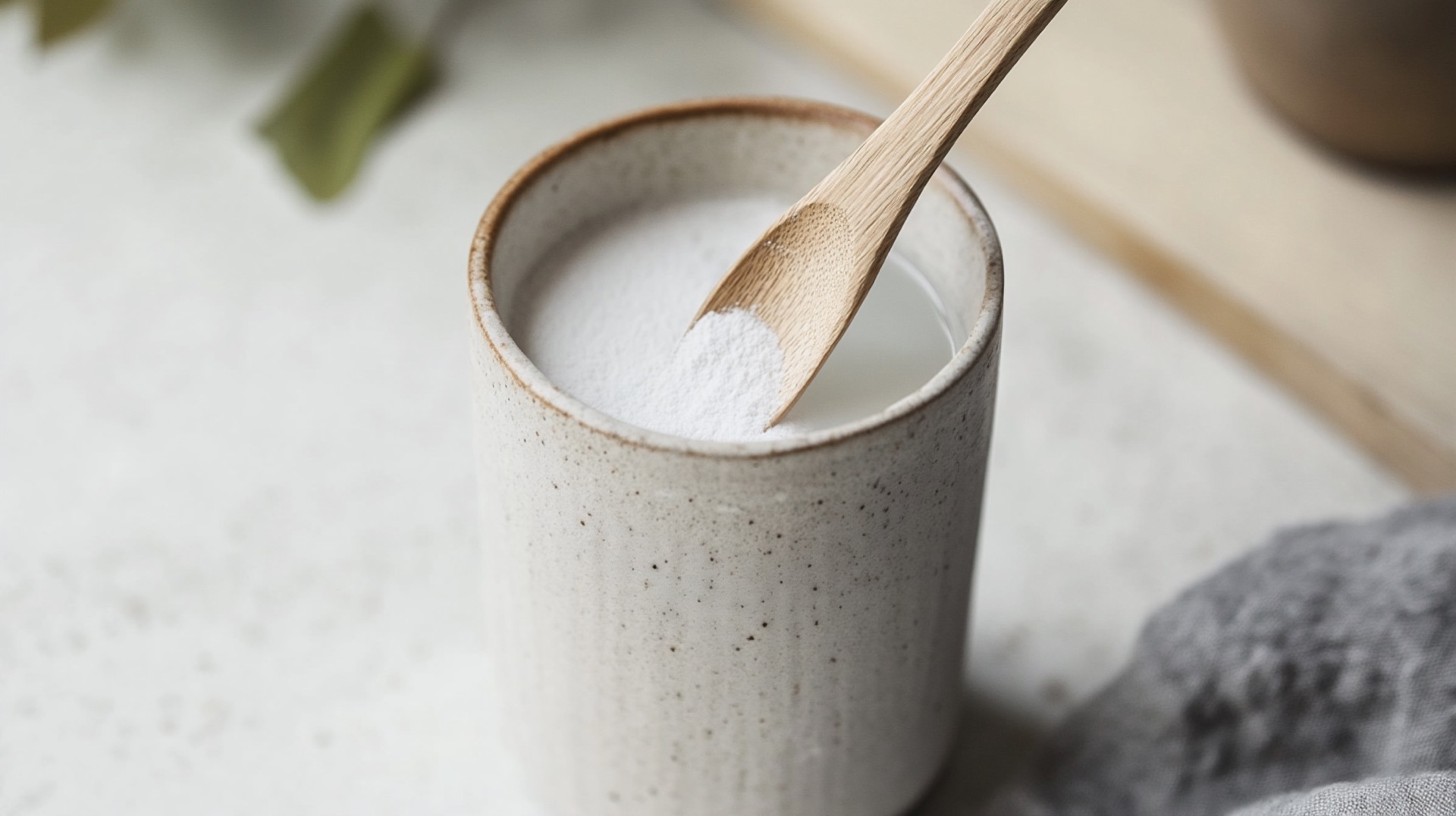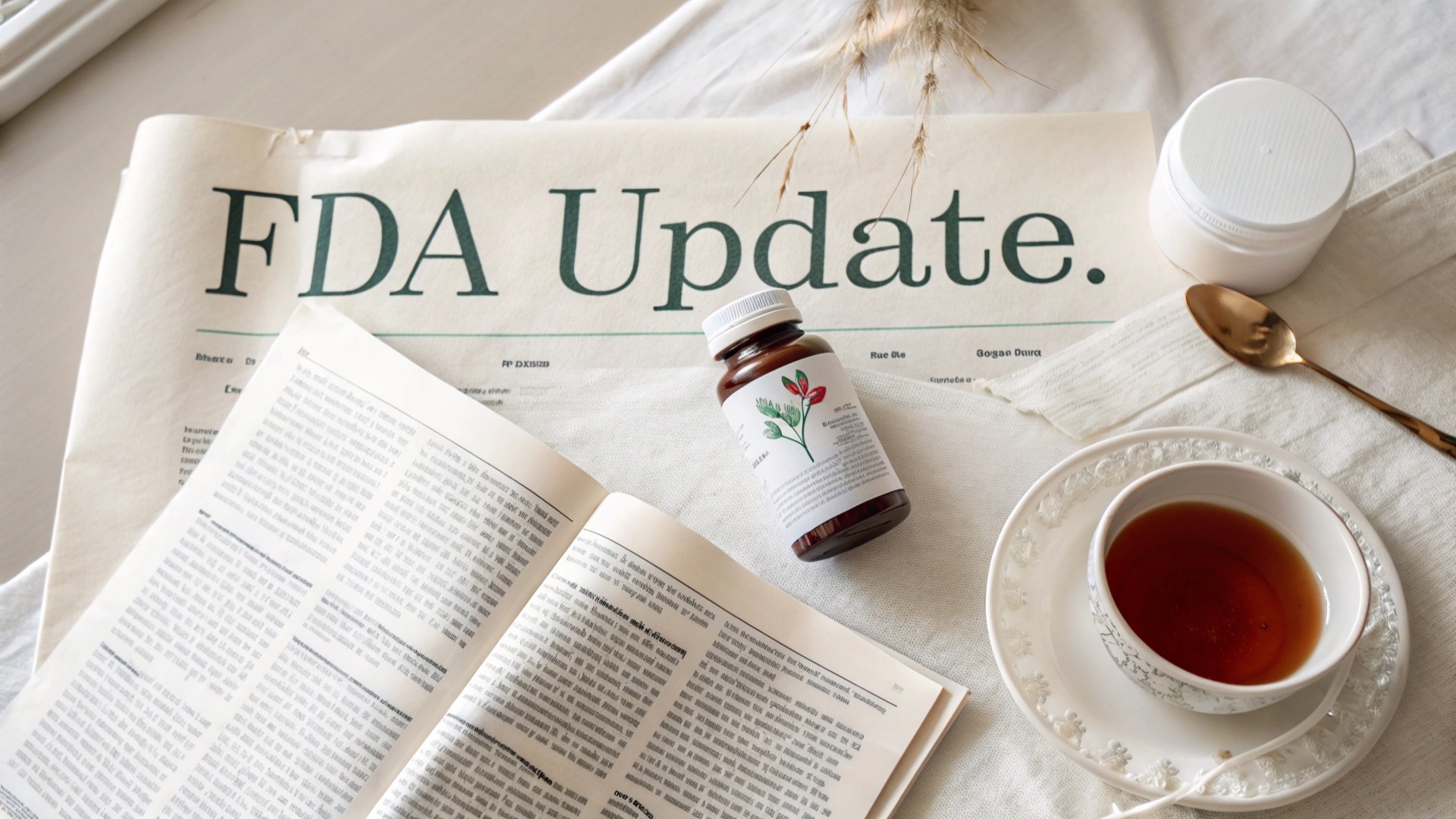Key takeaways
- Turmeric contains curcumin, a bioactive compound with anti-inflammatory, antioxidant, and antimicrobial properties that support skin health.
- Effective both topically and orally, turmeric may help alleviate symptoms of acne, hyperpigmentation, eczema, psoriasis, and signs of aging.
- Research supports its safety and efficacy, although mild irritation or temporary staining may occur in some individuals with sensitive skin.
Overview
You’ve likely stood in front of the mirror wondering what might finally solve your skin frustrations, whether it’s acne, dullness, or signs of aging. After trying every trending product with little success, it might be time to turn back to something timeless.
Turmeric, often tucked away in your spice cabinet, has been a cornerstone of traditional medicine for over 4,000 years, and now modern dermatology is paying attention. Rich in curcumin, turmeric boasts anti-inflammatory, antioxidant, and antimicrobial properties, making it an impressive natural remedy for a wide range of skin concerns.
From calming eczema and treating acne to fading dark spots and accelerating wound healing, turmeric’s skin-enhancing benefits are real and increasingly backed by research. This article breaks down 20 science-backed benefits of turmeric for your skin and shows you how to incorporate it into your routine safely and effectively.
Turmeric and its role in healing
Turmeric (Curcuma longa L.) is a perennial rhizomatous herb from the Zingiberaceae family, most commonly known as a kitchen spice that gives curry its distinctive yellow color. However, this vibrant root is far more than a culinary ingredient; it has been revered in Ayurvedic medicine for thousands of years.
The plant grows up to one meter in height with large oblong leaves and an underground rhizome that produces the familiar yellow-orange powder. India is the world’s largest producer, exporter, and consumer of turmeric, with annual production exceeding 10 lakh tonnes.
The chemistry behind turmeric’s skin benefits
Turmeric’s skin-enhancing properties stem primarily from its active compounds:
- Curcuminoids: Making up approximately 5% of turmeric, these are the primary bioactive substances giving turmeric its vibrant color. Curcumin is the most abundant and well-studied curcuminoid, known for its potent anti-inflammatory and antioxidant properties.
- Essential oils: Turmeric contains volatile oils, including turmerone, atlantone, and zingiberene that contribute to its therapeutic effects.
- Other compounds: The rhizome also contains proteins, resins, and various minerals that work synergistically with curcuminoids.
When applied to the skin, these compounds interact with cellular pathways, neutralize free radicals, reduce inflammation, and fight microbes—all contributing to healthier, more radiant skin.
20 science-backed benefits of Turmeric for skin
1. Combats acne and breakouts
Acne affects millions worldwide, and turmeric offers a natural solution through multiple mechanisms:
- Anti-inflammatory action: Curcumin inhibits nuclear factor-κB (NF-κB), a key mediator of inflammatory skin conditions, such as acne.
- Antimicrobial properties: Studies have shown that turmeric can help fight Propionibacterium acnes, the bacteria associated with acne formation. Curcumin in turmeric helps reduce inflammation and fights acne-causing bacteria, which contributes to overall skin clarity.
- Sebum regulation: Turmeric helps balance oil production, reducing the likelihood of clogged pores.
In a clinical trial, a combination of oral turmeric extract and topical turmeric cream resulted in a significant improvement in acne lesions, with 57.89% of patients experiencing “good to excellent” improvement. For best results, apply turmeric-based treatments gently to avoid irritating the skin.
2. Reduces hyperpigmentation and evens skin tone
Uneven skin tone and dark spots can affect your confidence, but turmeric offers a promising solution:
- Curcumin inhibits tyrosinase, an enzyme essential for melanin production, contributing to skin lightening.
- It helps fade existing dark spots by promoting cellular turnover.
- Regular application can prevent new hyperpigmentation from forming.
Regular use of turmeric can significantly improve skin complexion by reducing dark spots and evening out skin tone.
Many women in India have traditionally applied turmeric to their faces before taking a bath to improve complexion and reduce uneven pigmentation.
3. Fights signs of aging
Turmeric’s anti-aging benefits are awe-inspiring:
- Antioxidant protection: Curcumin neutralizes free radicals that accelerate skin aging.
- Collagen support: Studies suggest turmeric enhances collagen synthesis and prevents its degradation.
- Elasticity improvement: Regular use can improve skin’s natural elasticity and firmness.
- Reduce swelling: The anti-inflammatory properties of turmeric can help reduce swelling, which is beneficial for alleviating blemish-prone skin and relieving joint pain.
Combining turmeric with raw milk in face masks can enhance its anti-aging effects by providing additional hydration and nourishment.
A randomized, placebo-controlled, double-blind study by Sommerfeld (2007) found that a gel containing turmeric extract significantly improved skin firmness after just 4 weeks, with measurable decreases in skin aging parameters.
4. Soothes psoriasis symptoms
For psoriasis sufferers, turmeric offers hope through targeted action:
- Curcumin reduces the activity of phosphorylase kinase (PhK), an enzyme elevated in psoriatic skin.
- It helps normalize keratinocyte proliferation, addressing the rapid skin cell turnover central to psoriasis.
- Its anti-inflammatory properties provide relief from redness and irritation, and it has shown promising effects in treating chronic inflammatory disorders, such as rheumatoid arthritis.
Curcumin’s benefits extend beyond the skin, as it also helps reduce inflammation in blood vessels, which can be beneficial for conditions like rheumatoid arthritis.
In a controlled clinical study, a topical 1% curcumin gel resulted in 90% resolution of psoriasis after 2-6 weeks in half the patients, with the remainder experiencing 50-85% improvement.
5. Alleviates eczema and atopic dermatitis
Eczema sufferers can benefit from turmeric’s soothing properties:
- Curcumin reduces inflammatory cytokines, such as IL-4, IL-5, IL-13, and IL-31, which are involved in eczema flare-ups, thereby enhancing immune function.
- It strengthens the skin barrier function, which is which is crucial for managing eczema.
- Turmeric’s antimicrobial properties help prevent secondary infections common in eczema.
Turmeric’s ability to address various skin problems, including eczema, makes it a versatile remedy for improving overall skin health.
A four-week, open-label trial found that a topical cream containing turmeric significantly reduced eczema symptoms, including erythema, scaling, thickening, and itching.
6. Promotes wound healing
Turmeric accelerates the wound-healing process through multiple mechanisms:
- Enhanced granulation: Turmeric promotes the formation of granulation tissue, which is essential for wound healing.
- Collagen deposition: It increases collagen synthesis at wound sites.
- Reduced inflammation: Lower inflammation levels allow for more efficient healing.
- Improved neovascularization: Better blood vessel formation delivers more nutrients to healing tissues, enhancing blood flow.
Research shows turmeric accelerates wound contraction and increases tensile strength in healing tissues, making it valuable for both acute injuries and chronic wounds. For optimal results, rinse turmeric-based treatments with warm water to enhance their soothing effects and promote better healing.
7. Controls excessive oiliness
For those with oily skin, turmeric offers natural sebum regulation:
- It helps normalize sebaceous gland activity.
- Curcumin modulates hormonal influences on oil production.
- Regular use can create a more balanced complexion without over-drying.
Traditional use in India suggests that regular application helps manage oiliness while maintaining the skin’s natural moisture balance. Combining turmeric with olive oil can enhance its effectiveness in treating scalp conditions and regulating oil production.
8. Provides UV protection
While not a replacement for sunscreen, turmeric offers complementary photoprotection:
- Curcumin absorbs UVB radiation, providing a natural shield.
- It reduces UV-induced oxidative stress in skin cells.
- Turmeric helps repair existing sun damage when used consistently.
Using turmeric essential oil in skincare routines can provide additional protection against UV damage and enhance skin health.
Research indicates that turmeric can inhibit the increase in matrix metalloproteinases triggered by UV exposure, helping to preserve the skin’s structural integrity.
9. Brightens dull skin
Turmeric is renowned for its ability to enhance skin’s natural radiance:
- It improves microcirculation, bringing more oxygen and nutrients to skin cells and contributing to glowing skin.
- Gentle exfoliating properties remove dead skin cells.
- Antioxidants revitalize tired, lackluster complexions.
This brightening effect has made turmeric a staple in traditional Indian bridal skincare routines, where brides apply a turmeric paste before their wedding day to achieve a luminous glow. For best results, use turmeric combined with other natural ingredients to enhance its brightening effects and achieve a glowing complexion.
10. Minimizes pores
Enlarged pores can be aesthetically concerning, but turmeric helps in several ways:
- Astringent properties temporarily tighten pore appearance.
- Anti-inflammatory effects reduce pore-enlarging inflammation.
- By reducing sebum production, it helps prevent pore clogging, which can lead to enlargement.
Regular application in targeted areas can visibly reduce pore size over time. For optimal results, mix turmeric with other ingredients in equal proportions to create effective treatments for minimizing the appearance of pores.
11. Treats fungal skin infections
Turmeric demonstrates impressive antifungal properties:
- Studies show efficacy against dermatophytes, including Trichophyton rubrum, the most common cause of fungal skin infections.
- When combined with photodynamic therapy, curcumin has demonstrated complete inhibition of T. rubrum growth.
- It disrupts fungal cell membranes and triggers apoptosis in fungal cells.
This makes turmeric valuable for treating conditions like athlete’s foot, ringworm, and certain forms of dandruff. Research shows that turmeric affects fungal cell membranes, making it an effective treatment for various fungal skin infections.
12. Reduces under-eye dark circles
Dark under-eye circles can add years to your appearance, but turmeric helps through:
- Improving microcirculation in the delicate under-eye area.
- Reducing inflammation that can contribute to darkness and puffiness.
- Lightening pigmentation through tyrosinase inhibition.
Traditional remedies combine turmeric with pineapple juice or buttermilk for enhanced brightening effects around the eyes. Traditional remedies often use turmeric milk to enhance the brightening effects around the eyes and reduce dark circles.
13. Calms rosacea symptoms
For rosacea sufferers, turmeric’s anti-inflammatory properties offer significant relief:
- It inhibits cytokines that trigger facial flushing.
- Strengthens capillaries to reduce redness.
- Curcumin’s antioxidant effects neutralize free radicals that exacerbate rosacea.
While clinical studies specifically on rosacea are limited, the established anti-inflammatory mechanisms suggest that turmeric may be a promising natural approach. Using kasturi turmeric can enhance the benefits of natural treatments for rosacea, providing significant relief from symptoms.
14. Balances skin pH
Maintaining optimal skin pH (around 5.5) is crucial for skin health:
- Turmeric helps restore natural acidity when skin becomes too alkaline.
- It supports the acid mantle that protects against pathogens.
- Regular use contributes to a more balanced microbiome.
This pH-balancing effect helps maintain the skin’s natural defense systems and prevents conditions associated with disrupted pH. Incorporating turmeric water into your skincare routine can help maintain optimal skin pH and support overall skin health.
15. Alleviates pruritus (Itching)
Chronic itching can significantly impact the quality of life, but turmeric offers relief:
- Curcumin reduces the production of substance P, a key mediator in itch sensation.
- It modulates histamine response, reducing itch intensity.
- Anti-inflammatory properties address underlying causes of itching.
Turmeric’s anti-inflammatory properties also make it effective in addressing digestive disorders, which can indirectly alleviate chronic itching.
In a randomized, double-blind trial by Pakfetrat et al. (2014), patients with uremic pruritus who received turmeric capsules experienced a significantly greater reduction in itch severity compared to placebo.
16. Treats oral lichen planus
This inflammatory condition affecting the mouth can be painful and persistent:
- A 2012 study by Chainani-Wu et al. found that high-dose curcumin (6000 mg/day) significantly improved clinical signs and symptoms of oral lichen planus.
- Patients experienced reduced erythema and ulceration compared to placebo.
- The treatment was well-tolerated with no significant side effects.
Using turmeric-infused skincare products can provide additional benefits for managing oral lichen planus and improving overall skin health.
Lower doses (2000 mg/day) did not show significant effects, suggesting dose-dependent efficacy.
17. Protects against environmental pollution
Urban living exposes skin to numerous pollutants that accelerate aging:
- Curcumin neutralizes reactive oxygen species generated by pollutant exposure.
- It activates NRF2, a protein that triggers the production of natural antioxidants.
- Turmeric helps repair cellular damage from environmental toxins.
Regular use can serve as a protective shield against urban pollutants, helping to prevent premature aging and maintain skin health. Research indicates that turmeric enhances the skin’s ability to neutralize pollutants, thereby providing a protective shield against environmental damage.
18. Improves facial photoaging
Sun-related aging affects millions, but turmeric offers restorative benefits:
- Reduces the appearance of sun spots and hyperpigmentation.
- Improves skin texture and reduces roughness.
- Enhances dermal density through collagen support.
The Sommerfeld (2007) study found that turmeric-containing gel significantly improved clinical evaluation scores for photoaged skin compared to placebo. For optimal results, combine turmeric with other natural ingredients to amplify its anti-aging effects and enhance skin texture.
19. Prevents radiation dermatitis
Cancer patients undergoing radiation therapy often experience painful skin reactions:
- A study by Ryan et al. (2013) demonstrated that oral curcumin (6 g/day) significantly reduced the severity of radiation dermatitis in breast cancer patients.
- Patients taking curcumin experienced less moist desquamation (28.6% vs. 87.5% in the placebo group).
- Another study by Palatty et al. (2014) found that topical turmeric cream reduced Grade 3 dermatitis in patients with head and neck cancer.
These findings suggest turmeric is a promising supportive therapy during radiation treatment. Research indicates that turmeric influences the skin’s response to radiation, offering therapeutic benefits for managing radiation dermatitis.
20. Reduces appearance of stretch marks
While complete removal is difficult, turmeric helps minimize stretch marks:
- Improves skin elasticity, which is essential for preventing stretch marks.
- Promotes collagen production in affected areas.
- Enhances skin regeneration and cellular turnover.
Traditional applications combine turmeric with carrier oils, such as coconut or almond oil, for enhanced penetration and effectiveness. For best results, use turmeric mixed with carrier oils to improve its effectiveness in reducing the appearance of stretch marks.
How to incorporate Turmeric in your skincare routine?
Topical applications
- Basic turmeric face mask
- 1 teaspoon turmeric powder
- 1 tablespoon yogurt or honey
- A few drops of lemon juice (optional)
Mix ingredients to form a paste, apply to clean skin for 15-20 minutes, then rinse thoroughly. Use 1-2 times weekly. After the mask has dried, rinse thoroughly with warm water to enhance its soothing effects and ensure all residue is removed.
- Turmeric spot treatment
- ½ teaspoon turmeric powder
- 1 teaspoon honey
- A few drops of tea tree oil
Apply directly to blemishes, leave overnight, and rinse in the morning.
- Anti-aging turmeric serum
- ¼ teaspoon turmeric extract
- 1 tablespoon aloe vera gel
- 5 drops of vitamin E oil
Apply a small amount to the skin nightly after cleansing and before moisturizing. For enhanced benefits, consider adding a few drops of turmeric essential oil to the serum.
Oral consumption
Research indicates that consuming turmeric orally can also benefit skin health:
- Turmeric tea: Steep one teaspoon turmeric powder in hot water with lemon and honey.
- Golden milk: Mix turmeric with warm milk and a pinch of black pepper to enhance bioavailability. This turmeric milk, also known as a turmeric latte or golden milk latte, is popular for its immune-boosting and skin-cleansing properties.
- Supplements: Curcumin supplements (typically 500-1500mg daily) may provide systemic benefits.
- Turmeric water: Mix turmeric powder with water and drink it in the morning to boost overall health and skin benefits.
Note: Always consult a healthcare provider before starting any supplement regimen, especially if you have pre-existing health conditions or are taking medications.
Potential side effects and precautions
While turmeric offers remarkable benefits, be aware of these considerations:
Skin staining
Turmeric’s vibrant yellow pigment can temporarily stain light skin. To minimize this:
- Limit application time to 15 minutes or less
- Add yogurt or milk to masks to reduce staining potential
- Apply a gentle toner after rinsing to remove residual color
Allergic reactions
Though rare, some individuals may experience allergic reactions to turmeric:
- Always perform a patch test before the full application
- Discontinue use if redness, itching, or irritation occurs
- Those with known allergies to ginger family plants should exercise caution
Medication interactions
When consumed orally, turmeric may interact with:
- Blood thinners (increased bleeding risk)
- Diabetes medications (enhanced blood sugar lowering)
- Acid reducers (may increase stomach acid production)
Commercial Turmeric skincare products
The market now offers numerous turmeric-infused products:
- Cleansers: Gentle formulations that harness turmeric’s antibacterial properties
- Masks: Professional formulations balanced to minimize staining while maximizing benefits
- Serums and moisturizers: Often contain turmeric extracts or tetrahydro curcumin (a colorless derivative)
- Spot treatments: Concentrated formulas targeting specific skin concerns
Look for products containing effective concentrations (typically 0.5-1% curcumin) and complementary ingredients, such as vitamin C or niacinamide, for enhanced results. Look for turmeric-infused skincare products that offer moisturizing and rejuvenating benefits for dry skin.
Bottom line
Turmeric stands out as one of nature’s most potent skin remedies, backed by both centuries of traditional use and modern scientific research. Its unique combination of anti-inflammatory, antioxidant, and antimicrobial properties makes it effective against a wide range of skin concerns, from acne and psoriasis to aging and hyperpigmentation.
Whether applied topically or consumed orally, this golden spice offers accessible, natural skincare solutions with minimal side effects. As research continues to validate traditional knowledge, turmeric is likely to become an increasingly important component of both conventional and alternative dermatological treatments.
Remember that consistency is key, like most natural remedies, turmeric’s benefits unfold gradually with regular use. Start with smaller concentrations, perform patch tests, and give your skin time to respond to this ancient golden healer.
Frequently Asked Questions (FAQs)
- Can turmeric permanently stain my skin?
No, turmeric typically causes temporary yellowing that fades within 24 to 48 hours. To minimize staining, limit application time, add dairy products to masks, and cleanse thoroughly afterward. Using turmeric extract rather than raw powder can also reduce the potential for staining.
- How long does it take to see results from turmeric skincare?
Results vary depending on the skin concern and application method. For inflammatory conditions like acne, some improvement may be visible within days. For problems like hyperpigmentation or anti-aging benefits, consistent use for 4-8 weeks typically yields noticeable results. As with any skincare ingredient, patience and consistency are key.
- Is turmeric better applied topically or taken orally for skin benefits?
Both approaches offer benefits that often work synergistically. Topical application provides direct, targeted effects, ideal for localized concerns such as acne or dark spots. Oral consumption offers systemic anti-inflammatory benefits beneficial for widespread conditions like psoriasis or eczema. For optimal results, many dermatologists recommend a combined approach.
- Can I use turmeric if I have sensitive skin?
Yes, but with precautions. Start with a patch test and lower concentrations (¼ teaspoon rather than a full teaspoon in masks). Combining turmeric with soothing ingredients like honey, yogurt, or aloe vera can buffer potential irritation. If sensitivity occurs, discontinue use immediately.
- Does turmeric specifically help with acne scars?
Yes, turmeric can help fade acne scars through multiple mechanisms. Its anti-inflammatory properties help reduce post-inflammatory hyperpigmentation, while its ability to inhibit tyrosinase prevents excess melanin production in scar tissue. Additionally, curcumin promotes tissue remodeling and proper collagen formation, helping to improve scar appearance over time with consistent use.
References
- Asawanonda, P., & Klahan, S. O. (2010). Tetrahydrocurcuminoid cream plus targeted narrowband UVB phototherapy for vitiligo: A preliminary randomized controlled study. Photomedicine and Laser Surgery, 28(5), 679-684.
- Chainani-Wu, N., Madden, E., Lozada-Nur, F., & Silverman, S. Jr. (2012). High-dose curcuminoids are efficacious in the reduction in symptoms and signs of oral lichen planus. Journal of the American Academy of Dermatology, 66(5), 752-760.
- Chainani-Wu, N., Silverman, S. Jr., Reingold, A., Bostrom, A., Lozada-Nur, F., & Weintraub, J. (2007). A randomized, placebo-controlled, double-blind clinical trial of curcuminoids in oral lichen planus. Phytomedicine, 14(7-8), 437-446.
- Chatterjee, S., Datta, R. N., Bhattacharyya, D., & Bandopadhyay, S. K. (2005). Emollient and antipruritic effect of itch cream in dermatological disorders: A randomized controlled trial. Indian Journal of Pharmacology, 37(4), 253-254.
- Gopinath, H., & Karthikeyan, K. (2018). Turmeric: A condiment, cosmetic and cure. Indian Journal of Dermatology, Venereology and Leprology, 84(1), 16-21.
- Heng, M. C., Song, M. K., Harker, J., & Heng, M. K. (2000). Drug-induced suppression of phosphorylase kinase activity correlates with resolution of psoriasis as assessed by clinical, histological and immunohistochemical parameters. British Journal of Dermatology, 143(5), 937-949.
- Kurd, S. K., Smith, N., VanVoorhees, A., Troxel, A. B., Badmaev, V., Seykora, J. T., & Gelfand, J. M. (2008). Oral curcumin in the treatment of moderate to severe psoriasis vulgaris: A prospective clinical trial. Journal of the American Academy of Dermatology, 58(4), 625-631.
- Lalla, J. K., Nandedkar, S. Y., Paranjape, M. H., & Talreja, N. B. (2001). Clinical trials of ayurvedic formulations in the treatment of acne vulgaris. Journal of Ethnopharmacology, 78(1), 99-102.
- Pakfetrat, M., Basiri, F., Malekmakan, L., & Roozbeh, J. (2014). Effects of turmeric on uremic pruritus in end stage renal disease patients: A double-blind randomized clinical trial. Journal of Nephrology, 27(2), 203-207.
- Palatty, P. L., Azmidah, A., Rao, S., Jayachander, D., Thilakchand, K. R., Rai, M. P., … & Baliga, M. S. (2014). Topical application of a sandal wood oil and turmeric based cream prevents radiodermatitis in head and neck cancer patients undergoing external beam radiotherapy: A pilot study. British Journal of Radiology, 87(1038), 20130490.
- Panahi, Y., Sahebkar, A., Amiri, M., Davoudi, S. M., Beiraghdar, F., Hoseininejad, S. L., & Kolivand, M. (2012). Improvement of sulphur mustard-induced chronic pruritus, quality of life and antioxidant status by curcumin: results of a randomised, double-blind, placebo-controlled trial. British Journal of Nutrition, 108(7), 1272-1279.
- Pumthong, G., Asawanonda, P., Varothai, S., Jariyasethavong, V., Triwongwaranat, D., Suthipinittharm, P., … & Thuangtong, R. (2012). Curcuma aeruginosa, a novel botanically derived 5α-reductase inhibitor in the treatment of male-pattern baldness: A multicenter, randomized, double-blind, placebo-controlled study. Journal of Dermatological Treatment, 23(5), 385-392.
- Rawal, R. C., Shah, B. J., Jayaraaman, A. M., & Jaiswal, V. (2009). Clinical evaluation of an Indian polyherbal topical formulation in the management of eczema. The Journal of Alternative and Complementary Medicine, 15(6), 669-672.
- Ryan, J. L., Heckler, C. E., Ling, M., Katz, A., Williams, J. P., Pentland, A. P., & Morrow, G. R. (2013). Curcumin for radiation dermatitis: A randomized, double-blind, placebo-controlled clinical trial of thirty breast cancer patients. Radiation Research, 180(1), 34-43.
- Sommerfeld, B. (2007). Randomised, placebo-controlled, double-blind, split-face study on the clinical efficacy of Tricutan® on skin firmness. Phytomedicine, 14(11), 711-715.
- Vaughn, A. R., Branum, A., & Sivamani, R. K. (2016). Effects of turmeric (Curcuma longa) on skin health: A systematic review of the clinical evidence. Phytotherapy Research, 30(8), 1243-1264.
- Vollono, L., Falconi, M., Gaziano, R., Iacovelli, F., Dika, E., Terracciano, C., … & Campione, E. (2019). Potential of curcumin in skin disorders. Nutrients, 11(9), 2169.








